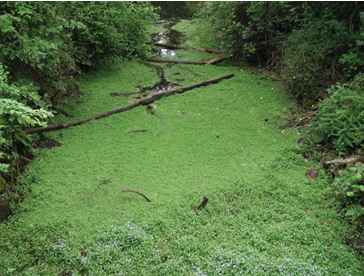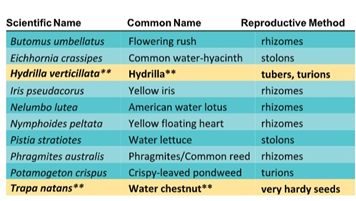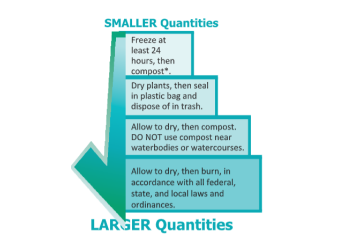A JOINT PUBLICATION FOR THE STATE OF CONNECTICUT
Produced by the Department of Energy and Environmental Protection and the University of Connecticut in cooperation with the CT Invasive Plant Working Group, the CT Agricultural Experiment Station, and CT Sea Grant
For a PDF version of this information, email Alyssa.Siegel-Miles@uconn.edu
Introduction
Efforts to control invasive plants may generate large amounts of plant material and soil or sediment containing viable plant parts. This material must be appropriately managed, or it could contribute to the re-establishment and spread of the species at the controlled site, the disposal site or landfill, or elsewhere. In many cases, plants may re-grow in future years. It is very important to monitor sites after control efforts to prevent invasive plants from re- establishing and re-invading the area. In general, it is best to control plants early in the season, before they begin to flower. In some cases, fruits and seeds can continue to mature even on plants that have been uprooted, so it is important to check plants for flowers before deciding on a disposal option. It is advisable to leave plants controlled by herbicides in place instead of removing them.
CAUTION! MANY AQUATIC INVASIVE PLANTS CAN BE SPREAD BY PLANT FRAGMENTS
This document focuses on the disposal of invasive plant material after control work takes place; it does not include information about invasive plant control. (An aquatic control professional can provide information on controlling invasive plants in private waterbodies.) Many aquatic plants spread by plant fragments, so extreme caution should be used when conducting aquatic invasive plant removal. Once control activities have concluded, use these general guidelines to dispose of invasive plant materials as safely and effectively as possible. Remember, each situation is unique; this document is intended only as a basic guide.

NO DUMPING
Many invasive aquatic plants are introduced to new areas when water gardeners or aquarium owners dump plants into a local water body. NEVER dispose of aquatic plants from fish tanks or water gardens into natural systems. Additionally, ensure that water gardens are located away from natural water bodies, where floods, animals, or other factors could contribute to the release of aquatic plants (or animals) into the environment.
LEGAL NOTES
It is illegal to transport material of any species listed under Connecticut General Statute Sec. 22a- 381d as an invasive plant, however, the statute includes an exception for the moving of plant material for the purpose of eradication. It is still illegal, however, to transport plant material of any kind (invasive or otherwise) on boats or boat trailers. Boats and boat trailers must be inspected for aquatic plants before being transported (CGS Sec. 15-180). Applications of herbicides in aquatic environments require a permit from the Connecticut Department of Energy and Environmental Protection (DEEP; CT Gen. Stat. Sec. 22a-66z). Applications of herbicides on a property that is not owned by you require a valid pesticide applicator’s license (CGS Sec. 22a-47). Burning may be conducted through the local Open Burning Official as required by CGS 22a- 174(f) if the town has an open burning program and the Open Burning office approves the proposed burn. Always check the local fire danger and the Air Quality Index before you burn and follow all federal, state, and local laws and ordinances when conducting invasive plant removal or disposal.

RECOMMENDED DISPOSAL METHOD BASED ON QUANTITY
IMPORTANT EXCEPTIONS
Although seeds, rhizomes, and other reproductive parts may survive the composting process, *do not compost aquatic plants if there is a possibility that compost from these plants may be used in, around, or near any type of water body. Do not send aquatic plants to a commercial or municipal compost site. The plants in the table to the right may also reproduce by seed, but even when seeds are not present, they should not be composted because of the possibility that material may survive in compost and spread to new locations when the compost is distributed. Use an alternate method to dispose of these plants.
AQUATIC INVASIVE SPECIES RESOURCES
- CT Agricultural Experiment Station Invasive Aquatic Plant Program (portal.ct.gov/caes-iapp)
- CT Dept. of Energy and Environmental Protection (portal.ct.gov/DEEP-AquaticInvasiveSpecies)
- CT Invasive Plant Working Group (cipwg.uconn.edu)
- UConn Extension / Connecticut Sea Grant (seagrant.uconn.edu/focus-areas/invasive-species)

Acknowledgements
This fact sheet is based on several previously existing works, including a non-native plant disposal document from UNH Cooperative Extension, a NH DOT Best Management Practices document, and an aquatic plant disposal document from the Invasive Plant Atlas of New England. Special thanks to K.C. Alexander, Greg Bugbee, Donna Ellis, Chuck Lee, Les Mehrhoff, Nancy Murray, Brad Robinson, Logan Senack, Stacey Stearns, Summer Stebbins, and the CT Invasive Plant Council for their contributions.

For a PDF version of this information, email Alyssa.Siegel-Miles@uconn.edu
